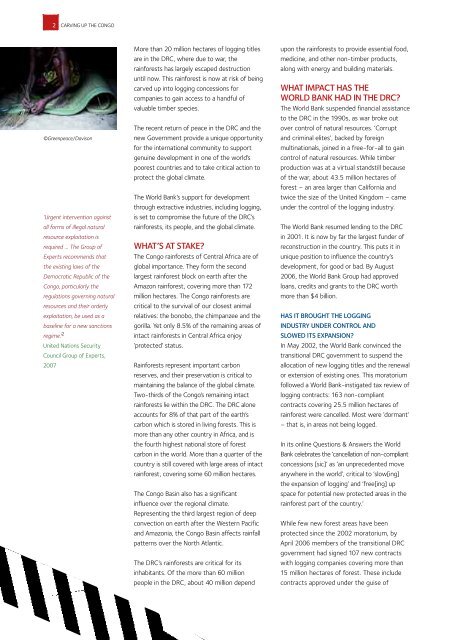Download Executive Summary - Greenpeace
Download Executive Summary - Greenpeace
Download Executive Summary - Greenpeace
Create successful ePaper yourself
Turn your PDF publications into a flip-book with our unique Google optimized e-Paper software.
2<br />
CARVING UP THE CONGO<br />
©<strong>Greenpeace</strong>/Davison<br />
‘Urgent intervention against<br />
all forms of illegal natural<br />
resource exploitation is<br />
required … The Group of<br />
Experts recommends that<br />
the existing laws of the<br />
Democratic Republic of the<br />
Congo, particularly the<br />
regulations governing natural<br />
resources and their orderly<br />
exploitation, be used as a<br />
baseline for a new sanctions<br />
regime.’ 2<br />
United Nations Security<br />
Council Group of Experts,<br />
2007<br />
More than 20 million hectares of logging titles<br />
are in the DRC, where due to war, the<br />
rainforests has largely escaped destruction<br />
until now. This rainforest is now at risk of being<br />
carved up into logging concessions for<br />
companies to gain access to a handful of<br />
valuable timber species.<br />
The recent return of peace in the DRC and the<br />
new Government provide a unique opportunity<br />
for the international community to support<br />
genuine development in one of the world’s<br />
poorest countries and to take critical action to<br />
protect the global climate.<br />
The World Bank’s support for development<br />
through extractive industries, including logging,<br />
is set to compromise the future of the DRC’s<br />
rainforests, its people, and the global climate.<br />
WHAT’S AT STAKE?<br />
The Congo rainforests of Central Africa are of<br />
global importance. They form the second<br />
largest rainforest block on earth after the<br />
Amazon rainforest, covering more than 172<br />
million hectares. The Congo rainforests are<br />
critical to the survival of our closest animal<br />
relatives: the bonobo, the chimpanzee and the<br />
gorilla. Yet only 8.5% of the remaining areas of<br />
intact rainforests in Central Africa enjoy<br />
‘protected’ status.<br />
Rainforests represent important carbon<br />
reserves, and their preservation is critical to<br />
maintaining the balance of the global climate.<br />
Two-thirds of the Congo’s remaining intact<br />
rainforests lie within the DRC. The DRC alone<br />
accounts for 8% of that part of the earth’s<br />
carbon which is stored in living forests. This is<br />
more than any other country in Africa, and is<br />
the fourth highest national store of forest<br />
carbon in the world. More than a quarter of the<br />
country is still covered with large areas of intact<br />
rainforest, covering some 60 million hectares.<br />
The Congo Basin also has a significant<br />
influence over the regional climate.<br />
Representing the third largest region of deep<br />
convection on earth after the Western Pacific<br />
and Amazonia, the Congo Basin affects rainfall<br />
patterns over the North Atlantic.<br />
The DRC’s rainforests are critical for its<br />
inhabitants. Of the more than 60 million<br />
people in the DRC, about 40 million depend<br />
upon the rainforests to provide essential food,<br />
medicine, and other non-timber products,<br />
along with energy and building materials.<br />
WHAT IMPACT HAS THE<br />
WORLD BANK HAD IN THE DRC?<br />
The World Bank suspended financial assistance<br />
to the DRC in the 1990s, as war broke out<br />
over control of natural resources. ‘Corrupt<br />
and criminal elites’, backed by foreign<br />
multinationals, joined in a free-for-all to gain<br />
control of natural resources. While timber<br />
production was at a virtual standstill because<br />
of the war, about 43.5 million hectares of<br />
forest – an area larger than California and<br />
twice the size of the United Kingdom – came<br />
under the control of the logging industry.<br />
The World Bank resumed lending to the DRC<br />
in 2001. It is now by far the largest funder of<br />
reconstruction in the country. This puts it in<br />
unique position to influence the country’s<br />
development, for good or bad. By August<br />
2006, the World Bank Group had approved<br />
loans, credits and grants to the DRC worth<br />
more than $4 billion.<br />
HAS IT BROUGHT THE LOGGING<br />
INDUSTRY UNDER CONTROL AND<br />
SLOWED ITS EXPANSION?<br />
In May 2002, the World Bank convinced the<br />
transitional DRC government to suspend the<br />
allocation of new logging titles and the renewal<br />
or extension of existing ones. This moratorium<br />
followed a World Bank-instigated tax review of<br />
logging contracts: 163 non-compliant<br />
contracts covering 25.5 million hectares of<br />
rainforest were cancelled. Most were ‘dormant’<br />
– that is, in areas not being logged.<br />
In its online Questions & Answers the World<br />
Bank celebrates the ‘cancellation of non-compliant<br />
concessions [sic]’ as ‘an unprecedented move<br />
anywhere in the world’, critical to ‘slow[ing]<br />
the expansion of logging’ and ‘free[ing] up<br />
space for potential new protected areas in the<br />
rainforest part of the country.’<br />
While few new forest areas have been<br />
protected since the 2002 moratorium, by<br />
April 2006 members of the transitional DRC<br />
government had signed 107 new contracts<br />
with logging companies covering more than<br />
15 million hectares of forest. These include<br />
contracts approved under the guise of




![[2007] EWHC 311 - Greenpeace UK](https://img.yumpu.com/22079793/1/184x260/2007-ewhc-311-greenpeace-uk.jpg?quality=85)












